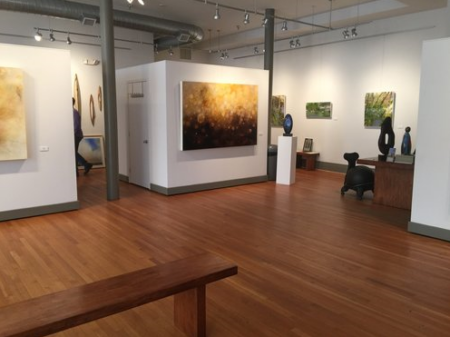Long-time professional artist Jack McGowan shares his expertise on developing relationships with galleries, and tips for readiness and success.

Artist and plein air painter Jack MacGowan
Here is my “Top 10” list (think David Letterman) on one of the most complex topics most painters ever tackle—getting into a gallery:
1. Do the work and make sure you’re ready
Hold the self-criticism. Pursuing gallery representation takes confidence. That said, be honest, prepare and offer your best work. Also keep learning. I recently fostered a relationship with master painter Bill Gallen, who invited me to join the Bettina Steinke Group. What a game changer! Doing the work pays off.
2. Build your brand
Beyond establishing artistic style, this is critical to becoming a professional painter. Beginning an art career is like starting any business—approach it the same way. One misconception is that you simply need a business plan, but you actually need a marketing plan. This defines ideal collectors who acquire (buy) your paintings. The marketing plan describes how businesses differentiate their offerings. In this case, that’s you and your art.
Galleries care about this because they must believe you can be successful together. They want to sell more paintings over time, and to know you can produce to keep pace. Share what you know about your collectors and how to reach them. If you want to earn enough income from painting sales, to paint full-time, marketing can’t be a bad word. Your plan sets goals, and makes it easier to articulate where you want to go and how to get there.
My marketing plan has five topics: Work (or artistic skill development), Place (where people buy paintings), Price, Promotion (advertising, articles, social media, etc.) and Financial (income goals). Set annual goals and execute the plan to establish and maintain your brand. It never stops.
3. Make a promotion toolkit
Create sales tools to start talking with galleries. Email, phone or stop by galleries to start, and be ready to tell your story. Build a professional website and keep it current with your bio, events and new paintings. Archive paintings as they sell.
Digital portfolios are great to supplement websites. People used to carry around folios of paintings, but today you can create high-quality portfolios using Powerpoint or Google slides, save them as PDFs and easily email them to galleries. In this way, your portfolio isn’t sitting in a pile on someone’s desk. When I was ready to bring paintings to my current gallery, I emailed my portfolio with my best available paintings. When I arrived, the gallery owner had already picked the ones she wanted. They were hanging on the gallery wall an hour after we finished negotiating terms.
Advertising is important too. Magazine representatives can be great resources. My first step toward being a professional painter was to volunteer as Marketing Chair for Plein Air Painters of New Mexico. This was invaluable in helping me build a network of gallery owners, artists and magazine staff, plus learning the art business. It helped me decide how and when to run ads. I want ads to create excitement and trigger actions. I advertise when I’m in juried shows, often in organization banner ads, at discounted rates. My ads run alongside top tier artists who are in the shows. They drive viewers to my website, and ideally to attend the show.
Website platforms that provide analytics are ideal to track traffic after you place ads. It’s also great to know if visitors click through your website, and to track impressions. Did someone look at your content and click to see your work? Platforms should also allow you to import your existing mailing list, add new users, plus offer email and newsletters.
4. Location, location, location
Real estate people believe this, and it’s similar for art. With galleries though, it’s not only about location, but also style and chemistry. Under “Do the Work” you should analyze galleries in cities and markets where you want representation. Which galleries are a good fit for your work? Do they have a track record of selling compatible artists, not too similar but worth comparison?
My friend John Meister does this across multiple art markets. He cultivates gallery relationships, and it has helped him get representation in multiple states. Visit galleries, have a conversation and get a sense of whether you could work with them. Representation is a partnership; you want to make sure it works for both you and the gallery.

5. Trial runs
Another strategy is to apply to juried shows held at galleries you want to approach. You can open a dialog and even better, if you sell a painting through that gallery during a hosted show, you will be noticed. There’s no better way to start a meaningful dialog than having a successful sale.
6. Cultivate relationships
Gallery owners are people. Like John, visit galleries, talk to owners, and get insights on their business practices. Maybe they’ll also share market trends. You’ll gain insight about chemistry between you. Again, painting sales in a show are great conversation starters about representation. This is differentiation. It makes you stand out from others. If you know artists who are represented there, ask about their experience. Don’t get so busy trying to get chosen by the gallery that you don’t complete your own due diligence. Make sure it can work for both of you.
Approach these relationships confidently. Galleries get countless contacts, particularly in hot markets, but if you’re talking seriously with the owner, you are a contender. That said, things can go awry. Don’t get discouraged. Go back to your plan and look for a better fit. When you feel that you’re close to finalizing a relationship, let them know how confident you are about the relationship. I did this by making the gallery an unique offer. To truly differentiate myself, I offered to write a check to advance commissions on the first three paintings sold. Remember, she had already sold one, so this convinced her that I was serious and confident—all of which made her commit to representation.
7. Ask to be represented
Emails or phone calls are a start, but there’s no substitute for face-to-face visits. Tell the gallery owner why you like the gallery and want to be represented there. Send your digital portfolio, and if relevant, remind them you’ve been in juried shows there. It may take multiple contacts. Don’t go overboard, but be persistent. Try to get an answer, and if it’s no, ask why. You can learn a great deal from hearing “no.” It will help inform your next gallery approach.
8. Negotiate
If the gallery owner says yes, don’t just say OK. Negotiate. You should already know what you want beyond representation. How many paintings do you want them to take? Do they agree with your pricing model? Will they do joint advertising? Will they do a solo show? Is this probational and if so, what will it take to make representation permanent? This is all important, but also get feedback on basic things, like paintings sizes they want, compositions of yours they like best, framing styles, etc.
9. Stay fresh
Getting into the gallery is a start, but remember it’s a partnership. You want them to sell your work, but can you help? Drop an email or visit to see how things are going. If you are planning an ad, tell them, and include the gallery name and website, even the logo. Also drop a few copies by when it comes out. Refer any leads from the ad to the gallery.
It is nice to sell paintings direct without commission, but your business relationship gets stronger when the gallery owner sees that you want to support the effort. Ask for feedback on gallery traffic and when it is time to trade out paintings. This keeps it fresh, along with bringing in new work as paintings sell. Bear in mind, even if you simply trade out work to keep things fresh, you can still rotate those paintings back later. The goal is to help keep the gallery vibrant and inviting to collectors.
10. Virtual art store room
Another way I keep it fresh is always sharing new work with the gallery. After completing a new painting, I send them an email with a high-resolution JPEG. But there’s more. Galleries rarely have storerooms, so I created a “Virtual Art Store Room” on Dropbox and shared access with the gallery. That offers another 6–8 paintings to them at any time. It keeps my new work front of mind with the gallery, but can also a useful sales tool.
For example, if a prospective buyer likes my work but can’t decide on a painting, the gallery can show them digital images of others. This may reinforce that they like one they selected to help close a sale, or they might see something else they like, and I could deliver it. I’m open if the gallery wants to change existing paintings for new art. In fact, I take it as a complement and am happy to deliver or ship new works.
Jack McGowan is President of the Plein Air Painters of New Mexico and a gallery represented oil painter living in Santa Fe, New Mexico. He taught University MBA Marketing courses while CEO of a successful company. This article comprises some of the ways that he is applying knowledge that he gained in those roles to his work as a professional artist.



Speak Your Mind